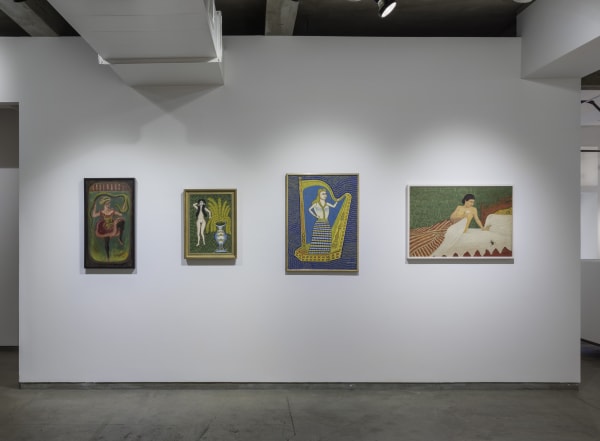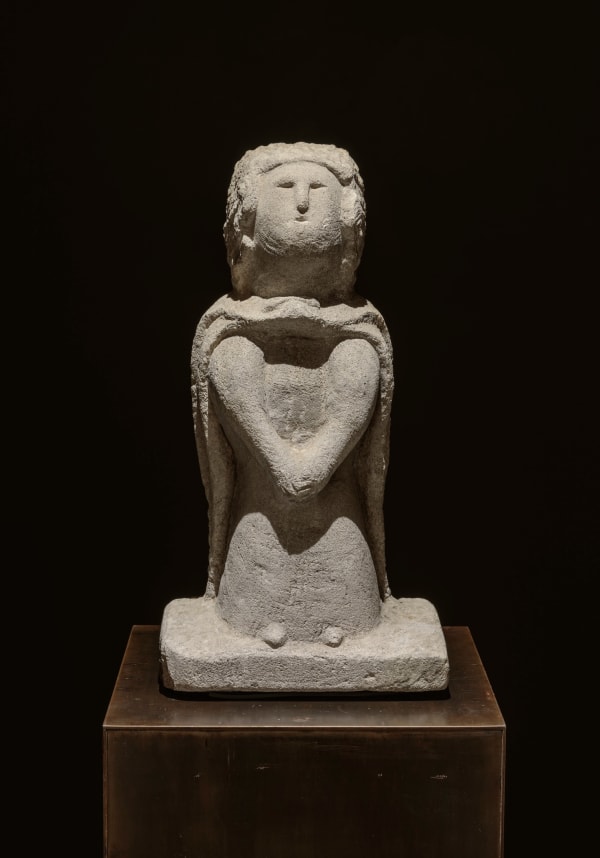Vernacular Woman
The introduction to Ricco/Maresca’s book American Vernacular reminds us that Dante was the first great “vernacular” poet in Western culture, as he wrote in Italian, the dynamic language of everyday life—rather than Latin, the stagnant lexicon of the church liturgy. As we understand it now, vernacular is the broad framework in which self-taught, outsider, folk, and “primitive” art occur. It encompasses the full spectrum of art making by, of, and for “the people;” all those creating on the margins of the academy. It relates differently (or not at all) to art historical narratives, to the waves of influence and rupture, and holds itself accountable only to the aesthetic sensibility and psychic compulsions of its makers.
Vernacular Woman presents depictions of women in several mediums (paintings, works on paper, and sculpture) by self-taught, outsider, and anonymous artists active in the United States between the late 18th century and the present year. We understand “woman” here as a visual idea; a familiar archetypal form, but also as a fluid concept that becomes richer and more nuanced with each distinct portrayal. As a collective, the women represented here tell an intriguing, open-ended story that bridges the ordinary with the uncanny and the frankly histrionic. The works in this exhibition are conventional, taboo, raw, sophisticated, disturbing, playful, beautiful, bizarre, perverse, hermetic, transparent… They speak to us with a sincerity, and a vitality, that comes from being unaware and unafraid of rules and expectations.
In a pair of drawings, respectively dated 1852 and 1853, Edward Durnford—a military man otherwise anonymous—rendered two likenesses of “Julia” at different moments in their presumed courtship. This is woman as wife, delicately recreated in graphite and blue colored pencil before photography transformed portraiture. Other representations of secular women include two needle prick watercolors found in New Orleans that could have been made as early as 1790, each presenting a figure standing in Little-Prince-like isolation, dressed in hybrid garbs illustrative of the African, French, and Caribbean cultural mélange of a southern city after the Revolutionary War; two works by Bill Traylor, women in motion—surely seized from the streets of Montgomery on a busy day between 1939 and 1942—and a female horse rider by Martín Ramírez (1954), smiling from her mysterious architectural stage like a memory captured in technicolor, her stallion’s hoofs matching her yellow pants, her red spurs echoing the linear iterations blushing around her. William Edmondson’s Lady with Cape (1935-40), one of the artist’s occasional earthly subjects, a kind of totemic female masterfully chiseled with minimal intervention on a chunk of limestone, is achieved with the same restraint as a small 1950s anonymous painted sculpture of a woman half immersed in water, emerging flawlessly from a solid block of wood that becomes a bathtub in a dance between illusion and abstraction.
Desire, sexual fixation, voyeurism, and pure fantasy permeate a number of works in this exhibition. An “erotic” cane (New England, mid to late 19th or early 20th century), guides the viewer through its unembellished shaft to focus on the carved handle: an upturned female figure in suspended motion designed to accommodate a hand ergonomically between her open legs. The Snake Dancer, a painting by Louis Michel Eilshemius from around 1915, presents us with a Dionysian can-can dancer holding a snake (their gazes locked with one another) against a backdrop of witchy green flames. Woman and Spider (1936), an oil on canvas by William Fellini, depicts a woman both thrilled and terrified to find a big black spider climbing up her bed. Morris Hirshfield’s Harp Girl II (1945) and Nude with Vase (1946)—a woman “sailing” a harp-boat and a standing nude next to a large neoclassical vase overflowing with ferns—both exude a gentle hypnotic sensuality pulsating throughout the woven patterns, textures, and theatrical “props” that were so vital to the artist’s vision. Gustave Klumpp presents us with a fantasy forest landscape of mixed perspective and scale (1971-72) that revolves around a woman, between a Venus and a bride, in a sheer white gossamer gown reclining on a hammock—her breasts and genitalia gratuitously exposed, shown from above for the viewer’s pleasure. Morton Bartlett photographed a nude inanimate girl-woman in lifelike manner (1950-60) whose preadolescent body he molded out of plaster around a wire skeleton. Bartlett’s game of make-believe was twice removed from reality, familiar and eerie in equal measures.
Another faction of artists regard woman as a classic muse and subject of unbridled fascination. A carving in giltwood and ebonized pine found in New England (early 20th century) portrays a nude female standing religiously still—the milky iridescence of her bare skin emphasized with an internal deco frame. Another carving depicts a kind of river nymph (1920-30) contemplating a butterfly resting on her right hand, and a sculptural torso of a bare breasted Hindu goddess (1925-35) observes the world with her immutable jeweled third eye. Helen Rae’s works on paper (2019) transform the spreads in fashion editorials into whole new worlds of collapsed three-dimensionality and vigorous color planes that convey a kind of drunkenness on beauty, wherever it may be found. Thornton Dial’s and Mary T Smith’s fluid, intuitive image-making transforms woman into semi-abstract matter. His works on paper and her paintings occurred in quick gestural fits. In Dial’s case, women are seen as sinuous, erotic beings (often transmigrating to fish and birds) for whom he expressed a physical and psychological curiosity. Smith’s works make us witness to an intensely personal spiritual journey where she recreates herself and those around her in bold animated brushstrokes.
Role-playing, alter egos, and performativity conclude this story. Lee Godie staged many photographic photobooth self-portraits (made between 1970 and 1994) in which she assumed different personas—the “French Impressionist” central among them—with the help of costumes, props, and face paint. She also often further altered her image by scratching or coloring over the surface of the prints. Edward Lawson’s drawings portray what seems to be a man in women’s clothing, perhaps Lawson himself, in glamorous dresses, elaborate coiffures, and dramatic makeup. Renaldo Kuhler feminized himself as “Renelda” Kuhler, a journalist for the New York Times who traveled frequently to Rocaterrania, a country of the artist’s invention, to report on the nation’s politics and culture. Kuhler conceived Rocaterrania as an autobiography and illustrated it for more than 60 years. His feminine doppelgänger is one of the more literal clues revealing that all the inhabitants of this nation—men, women, and neutants (asexual beings)—embody various facets of the artist, whose gender fluidity informed his vastly imaginative creation. Ursula Barnes’s I Cannot Choose (1930-40) is conceivably the most perplexing work in this exhibition, a melodramatic pastiche; part amateur painting, part German expressionist, and part circus banner. Like a Florine Stettheimer scene on crack, two clownish characters (a woman who could be a man and a man who could be a woman) occupy a kitschy exterior (or what could be a theatrical interior) heavily ornamented with Chagall-esque florals. The woman is surrounded by three jovial fluffy dogs and four puppies, the man holds a bouquet and looks at her expectantly, his red smiling lips a kind of counterpoint to her complacent pout. There’s an outrageous, mesmerizing “wrongness” here that’s somehow right.
***
The Museum of Modern Art was a pioneer in the presentation of vernacular art, in no small part due to Alfred H. Barr Jr., the museum’s young founding director, and the early involvement of the legendary collector, and later art dealer, Sidney Janis—who was invited to join the advisory board of the museum in 1934. Barr’s trailblazing vision of self-taught art as one of the three foundations of modern art—along with cubism and abstract art, dada and surrealism—and Janis’s passionate advocacy of American art—from abstract expressionism and pop to self-taught art—resulted in some of the most exciting exhibitions the museum has ever mounted. Among them, a one-person Edmondson show of sculpture in 1937 (the first in history by a self-taught, African American artist), Contemporary Unknown American Painters in 1939 (which introduced sixteen self-taught artists), and an unprecedented retrospective of work by Hirshfield in 1943, then a recently retired cloak, suit, and slipper manufacturer who had only started making art six years prior. Janis published the first comprehensive examination of self-taught art in the book They Taught Themselves (1942) with a foreword written by Barr, and through his own gallery, founded in 1948, he conceived the model for what we now call “crossover:” showing and promoting then emerging artists such as Pollock, de Kooning, and Warhol, and self-taught masters (Rousseau, Hirshfield, Kane, Pippin, Pickett) alongside European master works.
The now widely acknowledged paradox is that vernacular artists thrust mainstream art into modernity, inspiring what would become the avant-garde to forget their schooling so they could access the truest source of their own creativity. To this extent, we can agree that vernacular art comes from a more primal place, that it is different, and—most importantly—that the antagonism between high and low culture is false. Ricco/Maresca, picking up the baton of Barr’s and Janis’s legacy, continues to convey these beliefs. We define vernacular categories to better grasp how they can ultimately be surpassed, but also to understand how they relate to the full picture: like the dark side of the moon or the deep sea; generally invisible, still largely uncharted, but truly inextricable from the whole.
ALEJANDRA RUSSI
-
 Thornton Dial, Untitled (Seated Female Nudes with Bird), 1997
Thornton Dial, Untitled (Seated Female Nudes with Bird), 1997 -
 Renaldo Kuhler, Princess Nadanya de Rochelle, daughter of the Cesar, (portrait),, 1955
Renaldo Kuhler, Princess Nadanya de Rochelle, daughter of the Cesar, (portrait),, 1955 -
 Renaldo Kuhler, Renelda Kuhler, 1952
Renaldo Kuhler, Renelda Kuhler, 1952 -
 Gustave Klumpp, Untitled , c. 1971-72
Gustave Klumpp, Untitled , c. 1971-72



















